
by admin | Jun 16, 2011 | Greater New Orleans
6:15 a.m. and both kids were up and rearing to go. Charles was pulling on his shoes while asking me in the sweetest toddler voice possible, “Mommy, can we go on an adventure today?” August squealed in agreement. I checked the temperature, and it was already 80 degrees out and rising rapidly.
Over bowls of cereal, we struggled with our obvious dilemma–where could we go that was outside the city yet close enough to explore before the afternoon heat fried us all. “How about Camp Salmen?” Paul suggested, and off we went across the lake toward Slidell.
 |
| One of countless grasshoppers |
Home to boy scouts for nearly 60 years, Camp Salmen was later acquired by St. Tammany Parish and is undergoing a transformation into a nature park. As we stepped out into the baking heat, scenic Bayou Liberty beckoned us over to its cooling waters.
With every step we took forward, the ground seemed to come alive around us. Enormous grasshoppers circled our feet, and Charles thought we had brought him to Heaven. Overcome with both fear and excitement, he was shaking each time he reached his small fingers down to catch another one. Before we knew it, we had a Ziploc bag full of the black and red-striped insects.
 |
| Garden designed around Camp Salmen ruins |
The poor critters were carried on a tour across the property, from the boardwalk by the bayou to the garden-bed ruins. We made it through two separate trails before succumbing to the heat and running through a nearby sprinkler while retreating to the car. Our tour was enough to show that the parish has great plans for this work-in-progress park, which promises to be one of the most scenic sites in St. Tammany.
After a quick detour to the Dollar Store to buy another bug catcher, we stopped off in Old Towne Slidell for a burger and fried pickles at the Times Grill. The restaurant is located on Front Street, which runs along Bayou Bonfouca. Old Towne houses several antique shops, clothing stores and Heritage Park with its playground, walking paths and boat launch.
For the more adventuresome, Slidell is also the launching site for tours of Honey Island Swamp and The Nature Conservancy’s White Kitchen Preserve. Skipping the swamp tour for today, we did swing by The Nature Conservancy site where a short boardwalk offered a peak into the area’s wetlands as well as a chance to see a bald eagle nest.
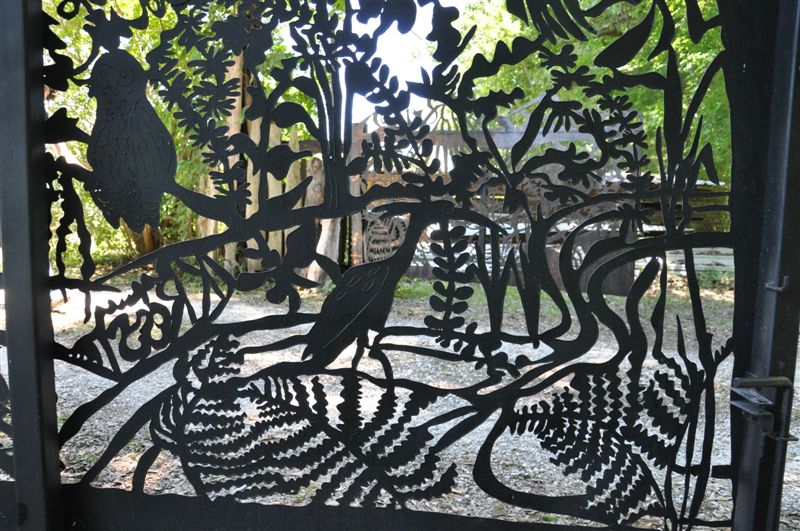
by admin | May 31, 2011 | Greater New Orleans
I’ll admit it, I’m a map junkie. Everyone nowadays has GPS in their cars or on their iphone, but I love the feel of an actual map in my hands. Sometimes when I’m bored, I’ll just pick up a map and start looking it over, searching for something I’ve never seen before. That’s how I first came across A Studio in the Woods, a tiny dot on a road I never knew existed.
 |
| A work of art greets visitors to A Studio in the Woods. |
 |
| Inside the Main House |
A quick Google search and I discovered an artist retreat hidden in 7.6 acres of forest. I quickly joined their mailing list and waited for an invitation to visit. The chance came with their 2nd Annual FORESTival in mid-May, when the front gates and doors to their homes were opened wide to visitors. The mini-festival, complete with music, fish tacos and children’s activities, was secondary to the real reason we visited — to see the house and studios and take a hike through one of the forest trails.
The main house, mostly built of reclaimed wood, was beautiful and eclectic at the same time. The cozy cabin feel of its initial core took on a disheveled look as assorted rooms were added in later years. Our time spent inside was cut short by two squirming kids, though, who we later occupied with lunch on a pier overlooking the pond.
 |
| Exploring the wooded trails |
We explored it all, touring the gallery of art work and trying our hand at making clay roots for a communal tree sculpture. For Charles, the highlight of his “adventure” was the cicada shell we found during our walk in the woods. He had brought along his bug catcher and was begging me to snag him a spider, but fortunately Paul satisfied him by finding the unoccupied shell clinging to a nearby tree.
August, on the other hand, simply took it all in, enjoying the day as much as any other. It was a nice, small outing, offering an enclosed space large enough to explore, but small enough to not worry about keeping tabs on your kid every second. On our way out, we admired the steel gates gracing the entrance before crossing the street and scaling the levee to take in the record-high waters of the Mississippi River.
 |
| Steel gates guarding the entrance |
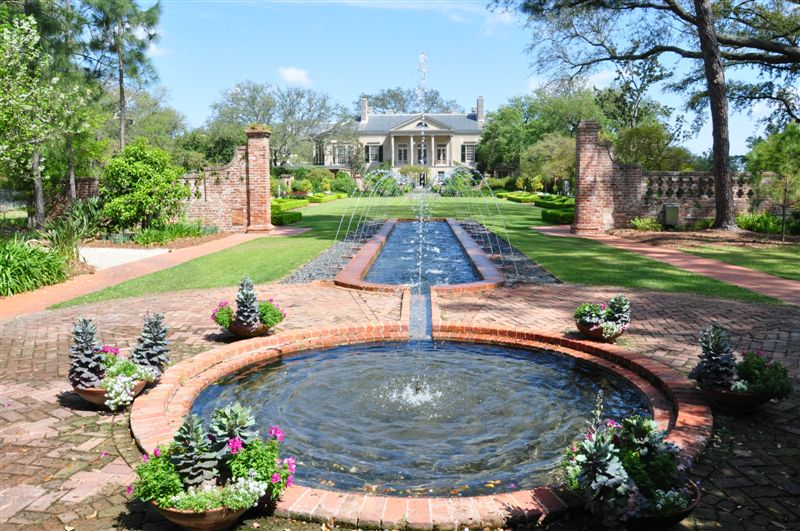
by admin | May 12, 2011 | Greater New Orleans
It was a typical morning, only 7:30 a.m. and Charles’ three-foot, stuffed T-Rex had already tried to eat August and had succeeded in eating his yogurt snacks. I had my exercise in for the day after chasing the squealing 3-year-old around the house in my desperate attempt to get him dressed, and somehow my basket of folded, clean laundry was now scattered across the kitchen floor. As I put my head down on the table, I found myself staring at three tiny snails and a shriveled up millipede that Charles so eloquently described as “broken.”
I knew we needed a plan to leave the house and fast, but we were still tired from our previous weekend in Lafayette and weren’t willing to venture too far. Paul and I scanned our mental list of things we needed to see in New Orleans and came up with Longue Vue House and Gardens. Both of us had worked in Old Metairie at one time or another and thus had passed the entrance to the house hundreds of times. Yet, the small sign from the road never seemed to promise anything special, and we simply overlooked the place for years. Boy, were we mistaken.
 |
| Iris-lined path in the Wild Garden |
Even the entrance, with its view down an oak alley to the main house, belied nothing more than a mansion with a great lawn. But we paid our entrance fee and carefully drove down a two-way, one-lane road to the parking lot. Taking my first glance at the map, I was surprised to see seven different gardens listed as well as a Spanish Court and the oak alley.
 |
| The herbs and vegetables of the Walled Garden |
We started in the Wild Garden, where butterflies flitted from one native plant to the next. Camellias, azaleas, irises, wildflowers and dozens of other plants and trees filled the area, with walking paths snaking between them and around the pond leading to the Pigeonnier. A small entrance then led you from the whimsical garden inside the symmetrical walls of a kitchen garden lined with herbs, fruits and vegetables.
Water was a central component of both the Canal and Pond Gardens, which fittingly ended with a colorful, wooden sculpture of a wave. The boundary lines were blurred between Longue Vue’s East Lawn and the New Orleans Country Club, and I experienced a brief moment of confusion after emerging from meticulous gardens to see a man-made hill acting as a buffer to flying golf balls. Live oak trees with expansive spreads graced the edges of the property.
 |
| A majestic live oak on the edge of the golf course |
The pebble and water marvel Spanish Court offered a stylish walk to the edge of the house, which we forewent touring with two small children. Thinking our tour was nearly over, we passed through a few smaller gardens to take a peak at the Discovery Garden before heading back to the car. Little did we know, this was to be the highlight of our trip.
 |
| Edible flowers in the Discovery Garden |
One of the largest landscaped areas on the property, this was a child’s dream come true. Every corner revealed a new surprise, from child-sized binoculars, shovels, trowels and even wheelbarrows to secret pathways, planting areas and worm digs. Charles enjoyed every inch of the property, exploring its full potential not once but multiple times. Our quick and easy trip turned into hours of enjoyment, and we made sure to pick up the brochure about birthday parties on our way out.
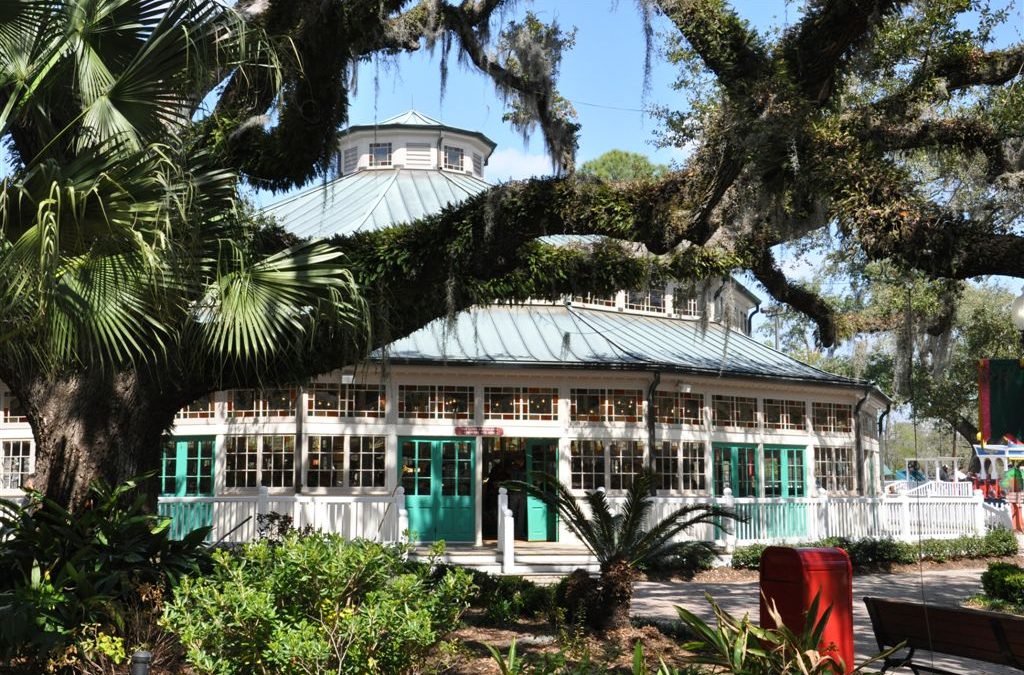
by admin | Apr 4, 2011 | Greater New Orleans
Journalist Chris Rose was on the news the other night expounding on how most people don’t play tourist in their own city. He, for example, had never been to the World War II Museum or Preservation Hall. While I had both of these covered, there were some places in New Orleans still left to discover. Take City Park. I have probably been there hundreds of times and, despite Charles’ wide-eyed, open-mouthed stare every time the pint-sized train tooted past us, I had never ridden with him on it. So today we were taking a concentrated section of the park and exploring its full potential.
 |
| Miniature train garden in the Botanical Garden |
We started off low-key with a leisurely stroll through the Botanical Garden. (A useful tip, buy a City Park membership, and enjoy free admission to the Botanical Garden, Storyland and the Amusement Park.) Built by the Works Project Administration (WPA), the Garden takes you on a winding journey past fish ponds, a rose garden, ancient live oaks, a butterfly garden, a Japanese tea garden and much more. Flowing sculptures by Enrique Alferez hold prominent spots among the vibrant flowers.
A favorite of my three-year-old was the tropical rainforest, where a surprise snake hides deep within the waterfall’s cavern. The only way we could lure him away was by tempting him with the hunt for lizards in the cactus garden. The final stop was the miniature train garden featuring small streetcars and trains chugging along amidst carved New Orleans homes and buildings. It’s the perfect place to build anticipation and excitement over the upcoming train ride.
 |
| Mother Goose takes flight in Storyland |
A short walk down the road past a giant Little Bo Peep and Humpty Dumpty lies the entrance to Storyland – a whimsical playground for young children. While Charles pretended to be Captain Hook battling Peter Pan on board the pirate ship, August came out of his usual Moby-wrap induced sleep and opened one eye to peer warily at the Big Bad Wolf hiding in Grandma’s House. From Pinocchio’s whale to the old lady who lived in a shoe, every childhood fairytale memory was vividly brought to life.
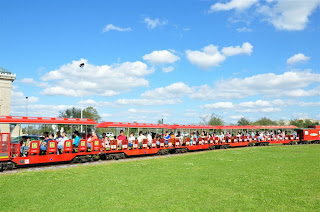 |
| City Park’s train |
Storyland’s back gate opens up into an amusement park complete with a roller coaster, twirling and spinning rides and country fair-style games. The lights and sounds were still scary to the eyes of a toddler, so we bypassed it all heading to the far side of the park. Only the carousel, exquisitely restored after Katrina, caused a slight pause in reaching our destination. But when we saw the crowd boarding the train, we ran to catch up and grabbed two seats near the very back.
With a blow of its whistle, the train pulled out onto the tracks, taking us on a sightseeing tour of the south side of the park. We waved at bystanders, pointed out the swans relaxing under a bridge and watched the streetcar clatter by on Carrollton Avenue. The duration was just perfect as attention spans were maxing out right as we pulled alongside the Botanical Gardens and soon slowed to a stop.
 |
| Irises blooming in the Sculpture Garden |
Breaking for a snack and juice, we enjoyed two minutes of relaxation before carrying on to one of my favorite places in City Park – the Sculpture Garden. Anything goes here in this artistic haven, from monkeys morphing into humans and an enormous spider with spindly legs to blue dogs and oversized Mardi Gras beads in trees. April is iris time in south Louisiana, and we were greeted with a rainbow of blooming irises gracing the edge of the water that cuts a path through the sculptures.
It was a packed morning and early afternoon, but for once, we made it home in time for a late lunch and Charles’ nap. Meanwhile, my daydreams of catching a few minutes of shut eye were dashed once I realized, after having slept through most of our day’s adventures, August was now rearing to go…
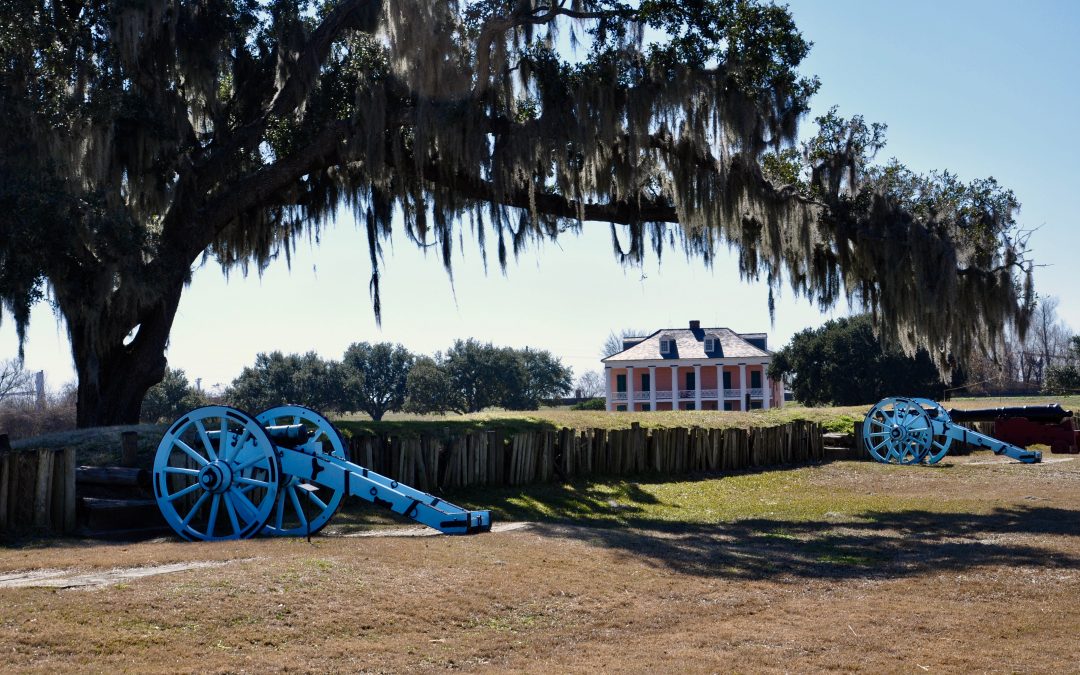
by admin | Mar 29, 2011 | Greater New Orleans, Most popular
Lured into St. Bernard Parish by a festival, we ended up staying late into the evening to see plantations, a battlefield and chickens. That’s right, chickens kept us out way past nap time. But I digress. It all started when I saw the newspaper article about the Los Islenos Festival. Having skipped it the last two years, I was determined to go. So we called a friend who lived in “The Parish,” as St. Bernardians call their beloved home, and made plans to meet up with her there.
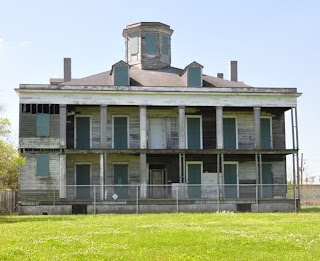 |
| LeBeau Plantation |
Driving along the back end of the French Quarter, past Bywater and the Lower Ninth Ward, we had a short pit stop to see two plantations that, although within walking distance of each other, are as different as night and day. LeBeau Plantation’s boarded up remains stand eerily proud behind a deep, grass field and a chain link fence. The new roof is in curious contrast to the gaping holes in the wall, but the home lends itself to being photographed. Meanwhile, on the property of the Domino Sugar Plant, the stately Cavaroc mansion appears well-loved in its pristine state. A word to the wise, though, snapping a picture of this beauty will earn you the disdain of the Domino Sugar guards, who descended upon our car, scrawling down our name and license plate number like we were suspected terrorists.
 |
| Chalmette Battlefield |
Fleeing the scene of the crime, we continued on to Chalmette Battlefield, which marks the site of the Battle of New Orleans where General Andrew Jackson and his ragtag group of American troops held off the British attack during the final struggle of the War of 1812. Beginning in the newly built visitor’s center, we pressed the button to start the video while I mentally calculated how long I had before having to take off in a chase after Charles. Amazingly, the moving lights of an accompanying diorama kept his attention, and for the first time in years, we were able to see an entire movie. In the end, I broke his attention and dragged him away to look at a large drum so he didn’t see the final results of the war graphically displayed across the screen.
Back outside, he proudly waved his miniature American flag while we led him toward the oddly small Beauregard Plantation, built on the property in 1840. After posing for family pictures in front of our pretend home, we explored the empty rooms inside. The temperature dropped remarkably when we stepped onto the marble floors and felt the cool breeze blowing across the open, facing doors in every room. August lazily watched Charles racing through the house, while I stopped the toddler in his tracks by pointing out a “secret” door to the attic. Little did I know that the door would become the primary topic of discussion for the rest of the day, leading to elaborate stories about a six-armed green monster locked away by the superhero Batman.
The plantation sits on the edge of the Mississippi River levee, and after a quick climb up the steps, we were delighted to catch a glimpse of the Creole Queen paddlewheeler floating by. Another top attraction at the site is the multitudes of crawfish chimneys lining the path to the cannons. Charles was fascinated with peering inside, desperately trying to see the crawfish at the bottom.
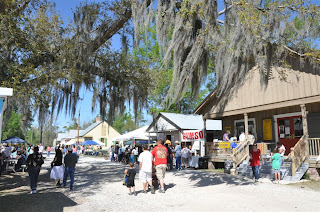 |
| Los Islenos Festival |
Now starving, we made a beeline down the San Bernardo Scenic Byway, passing under an avenue of live oak trees flanking the roadway, to the food booths at the Los Islenos Festival. Advertised as “A celebration of Louisiana’s Spanish Heritage,” the festival paid tribute to the Canary Islanders who settled in the region in the 1700s. Along with Spanish food, music and dancing, we found local craft booths and spacewalks scattered throughout the Los Islenos Historic Village. After refueling on paella and sangria, we explored the museum-quality homes and their endless contribution of “secret doors.”
We enjoyed a few moments of rest while listening to the large group of Spanish singers on stage before packing everyone up and heading home. One last detour was meant to be a quick in and out picture of the Sebastopol Plantation. Being a private residence, we were surprised to see a sign advertising free tours from noon to 4 p.m. Not only is it a rare event to stumble upon free entrance into a plantation, it is even more amazing that at 4:30 p.m., the owner and curator, Alberta Lewis, saw us stop our car and came to offer us a tour past closing time.
 |
| Sebastopol Plantation |
Charles, August and I made it almost through the history of the first room before having to go outside and spare the house from damage. While Paul was given a guided presentation of the 180-year-old house, the kids and I met a friend of the owner who engaged Charles in picking up pecans across the expansive yard. He then led us to the chicken coop, where roosters, chickens and two peacocks strutted all around our feet. We left carrying a basket of pecans, half a carton of fresh eggs and a lasting memory of the generosity of two St. Bernardians (one of whom also happened to be the talented artist behind Haydel’s king cake dolls).
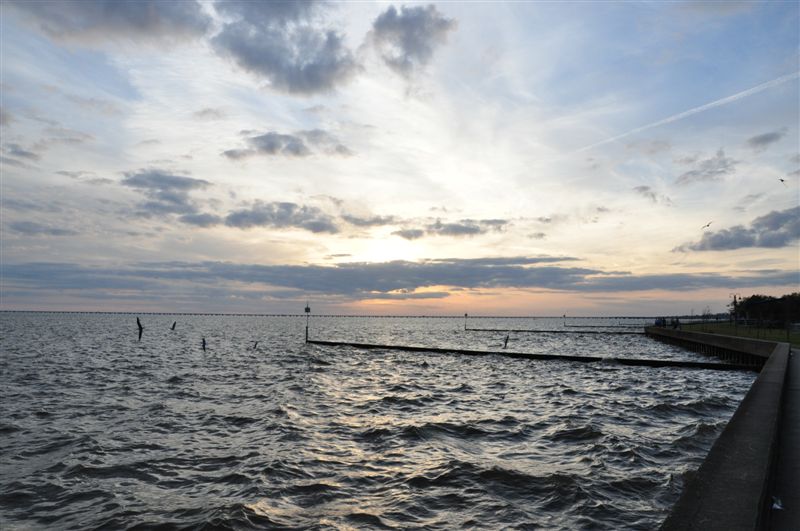
by admin | Mar 14, 2011 | Greater New Orleans
Every Monday morning, thousands of people wake up at the crack of dawn to leave their homes and drive across the longest bridge in the world to their jobs in the city. A lover of sleep and a hater of traffic, I’ve always wondered what could possess someone to willingly choose that daily commute across Lake Pontchartrain. But as one coworker described it, there’s a certain point on the drive home when the New Orleans’ skyline fades away and so does all the stress that comes with it. St. Tammany Parish, also known as the Northshore, is home to quaint towns that pride themselves on not being a suburb of New Orleans. This weekend, we decided to see what it is about the Northshore that lures people across that 24-mile-long Causeway Bridge.
Getting a late start, we were already hungry for lunch before we reached the Interstate. So we rerouted our original plans, bypassing Mandeville and Covington and heading straight for Abita Springs and the Abita Brew Pub. Once the home to the actual brewery, now the restaurant serves up oversized portions of salads, hamburgers and other entrees along with a wide selection of Abita beer. Eating establishments are always touchy with two small kids, but the free crayons and coloring sheet went a long way toward keeping Charles in check until his shrimp and french fries arrived. Of course, he scarfed them down in 2.4 seconds and then bolted out of his chair in search of mischief. Luckily, I have learned to eat equally fast and was able to guide him out the door while my husband, Paul, paid.
 |
| Indian princess kneeling over the spring |
Abita Springs is tiny as far as towns go. It’s one of those places where if you blink while driving too fast, you’ll miss the downtown. You’ll be sorry if you do, though. Walking out the front door of the Brew Pub, we found ourselves standing on the Tammany Trace, a railroad track turned into a bike/jog/horseback ride path that runs across St. Tammany Parish. The Trace plunges you deep into nature and then opens up at each town or city it passes. Dodging the bicyclists, we crossed the trail and headed toward the large gazebo built in 1884 for the New Orleans World’s Fair. It was reconstructed over — what else — but the famous spring that once lured tourists with its clean waters. Today, a statue of an Indian princess kneels over the bubbling water.
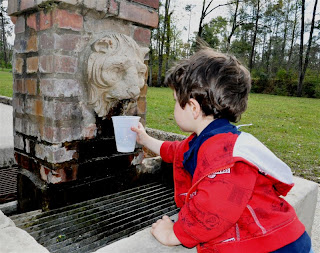 |
| Lion’s Head fountain pouring spring water |
As we walked toward the town museum, Charles spotted a man carrying an instrument and ran off to investigate. Within minutes, several more musicians arrived and started up their weekly concert. We admired the music until the museum guide revealed to Charles the secret for starting up the water park and then gave him a cup to collect water from the lion’s head fountain. He was so fascinated by drinking the water pouring out of the lion’s mouth that he never even noticed the playground looming large behind us.
Anxious to continue our journey, Paul steered us toward the car and the Nature Conservancy’s Abita Creek Flatwoods Preserve where a boardwalk runs through a long-leaf pine savanna and swamp. Unfortunately, the carnivorous yellow pitcher plants were not in season, but it was still a pleasant walk on a perfect, 70-degree day.
Back on the road, we headed south on 59 and stopped off at Tammany Trace Headquarters and the Kids Konnection playground. While I fed August his unappetizing jar of turkey and vegetable dinner, Paul and Charles went off to play in the sand pit. At the visitor center half a mile down the road, we picked up glossy brochures highlighting all the places we missed before continuing on to scenic Mandeville. A drive along the shores of Lake Pontchartrain tempted us to stop the car and take a stroll. Behind us, couples enjoyed romantic dinners in restaurants overlooking the sun setting on the massive lake.
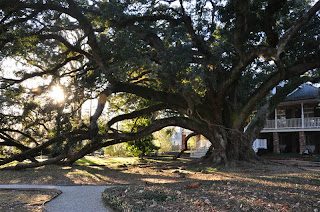 |
| Seven Sisters live oak tree |
There was only time for one last stop before making our way back across the bridge, and Paul led us deep into a neighborhood to find the Seven Sisters, the oldest live oak tree in Louisiana. He couldn’t hide his enthusiasm at finding the gem and had to sneak up the driveway of the private property to take this picture.
While the kids were lulled to sleep by the monotonous bumps of the bridge, I pulled out the brochures and made a quick wish list for the future. We had only touched the stem of St. Tammany Parish and had much to go back and see. So what’s on the list for next time? Well, for starters, there’s Fountainebleau State Park, Camp Salmen, the Global Wildlife Center, Saint Joseph Abbey, and on and on and on…



























